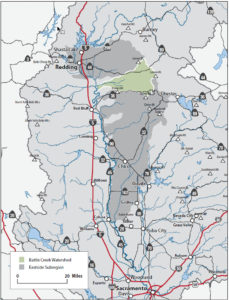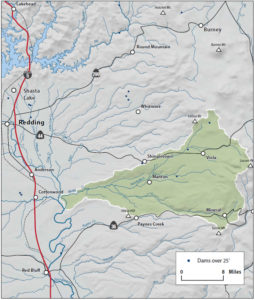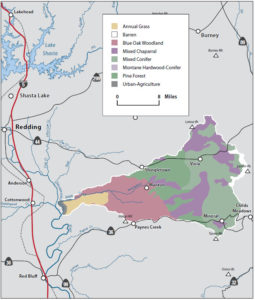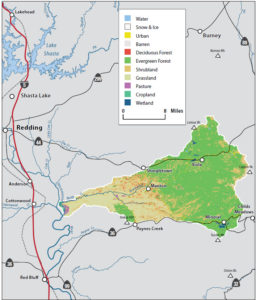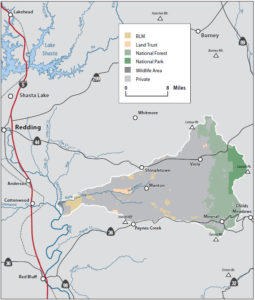Lower Battle Creek near the Sacramento River
Overview
The Battle Creek Watershed drains an area of approximately 370 square miles on the eastside of the Sacramento River in Shasta and Tehama Counties. The watershed is unique because of its volcanic geology and year-round cold and plentiful streamflow. Battle Creek may be the only remaining stream, other than the mainstem of the Sacramento River, that can successfully sustain breeding populations of steelhead trout and all four runs of Chinook salmon. For that reason, state and federal agencies have made it their highest priority in the effort to restore the declining runs of Sacramento River anadromous fish populations. Watershed topography ranges from the alpine areas high in Lassen Volcanic National Park, down through conifer forests, oak woodlands, and foothill areas, through rugged canyons to the floodplain and riparian forests along the Sacramento River. There is extensive acreage of both public (USFS and BLM) and private land (commercial timber and family-owned ranches and small farms). Communities in this sparely populated watershed are small and unincorporated.
Hydrology
Battle Creek exhibits a unique hydrology that results from the volcanic nature of the drainage. Seasonal precipitation does not rapidly run off the watershed as with streams situated farther south in the Sierra Nevada. Instead, a large portion of the annual water charge percolates through the volcanic strata and emerges throughout the watershed as cold springs that ensure a relatively high and stable base flow throughout the year. From 1940 to the present, the USGS has operated a stream gage in Lower Battle Creek located downstream of the Coleman National Fish Hatchery near the Sacramento River. Average daily flow in Battle Creek over the period of record is in the range of 1,000 cfs, and summer dry-season flows rarely fall below 200 cfs. The estimated record peak flow is 35,000 cfs in December 1937. In the early 1900s a complex network of dams, diversions, canals, pentstocks, and powerhouses were constructed on both NF and SF Battle Creek to produce electricity. Owned and operated by PG&E, these facilities significantly modify instream flow conditions in a major reach of Battle Creek. That system is currently under modification as part of the Battle Creek Salmon and Steelhead Restoration Project.
Water Quality
Given the year-round, high-volume flow of water in Battle Creek, water quality is generally very good and supports a variety of coldwater aquatic species, including large runs of anadromous salmon and steelhead. Water quality issues in Battle Creek have centered on temperature and sediment conditions. In 2001, a watershed assessment was conducted to evaluate instream sediment conditions in the upper watershed. Fine sediment levels were found to be higher than favorable for salmonid production but similar to levels in other northern California streams. A 2006 repeat of this study found more favorable stream conditions indicating an improving trend. Temperature has been an ongoing concern, particularly in stream reaches where flow is substantially reduced by hydropower operations. Another potential concern has been nutrient enrichment from the large number of fall-run salmon carcasses in Battle Creek downstream of the Coleman Hatchery.
Vegetation
The upper watershed is dominated by pine and fir stands that support commercial timber production on both public and private lands. Mid elevations are mostly blue oak and annual grassland. The upper watershed also contains expansive mountain meadow areas. Riparian vegetation is particularly prominent along lower Battle Creek near where it enters the Sacramento River. Irrigated land is mostly in pasture with some specialty crops that include an expanding acreage of vineyards in the Manton area.
Fish and Wildlife
The Battle Creek Watershed is a focal area for restoring populations of Chinook salmon and steelhead in the Sacramento River Basin. Approximately 250 miles of stream are fish-bearing, and 87 miles historically were accessible to anadromous fish. Hydroelectric development began on Battle Creek in the early 1900s, and this substantially altered the available habitat for anadromous fish production. Today, natural spawning occurs mainly in the lower 6 miles of the creek downstream of the Coleman National Fish Hatchery. The Coleman Hatchery began operations in 1943 as mitigation for the loss of salmon spawning habitat caused by the construction of Shasta Dam on the mainstem of the Sacramento River north of Redding. As recently as 2005, 80,000 salmon entered Battle Creek to return to the hatchery. However, in recent years, because of the overall decline in Sacramento River salmon, that number has fallen below 10,000. The Battle Creek Salmon and Steelhead Restoration Project was initiated in 1995 as a multi-agency effort to improve fish passage and habitat conditions within the portion of the watershed encompassed by PG&E’s Battle Creek Hydroelectric Project. The project includes removal of five diversion dams, placement of new screens and ladders on three other dams, and increased stream flow in both the north and south forks of Battle Creek, restoring approximately 42 miles of habitat in Battle Creek and an additional 6 miles of habitat in tributaries to Battle Creek.
Life in the Watershed
A prominent feature of the upper watershed is the Lassen Volcanic National Park, established in 1916 as this country’s thirteenth National Park. It includes four major geophysical regions; four National Recreation Trails; the world’s largest plug dome volcano; a 900-foot escarpment created from a fault fracture; habitat for 360 species of wildlife including bald eagle, osprey, black bear, mule deer, and rainbow trout; and expansive vistas of sage, pine, fir, and Sierra mountain streams. The Lassen National Forest surrounds the park and encompasses 1.2 million acres of recreational lands and productive commercial timber stands. The mid-reaches of the Battle Creek Watershed include thousands of acres of private timberland, family-owned ranches, and small farms producing a variety of products such as apples, alfalfa, Christmas trees, and grapes. The communities are small and unincorporated. They include Manton (population 1,300), Mineral (population 60), and Shingletown (population 12,000). There are several private, state, and federal fish hatcheries that take advantage of the large supply of cold, clean spring water. An expansive system of dams, canals, and powerhouses was acquired in 1916 by PG&E and has been in operation since that time. The BLM Sacramento River Management Area in Lower Battle Creek Watershed is managed for natural values, outdoor recreation, and protection of archaeological resources.
Management Objectives
Management in the Battle Creek Watershed is focused on the unique opportunity to restore declining populations of salmon and steelhead. Other management issues also important to the watershed community include fuels and fire management, control of invasive weed species, and preservation of the rural landscape and lifestyle. The Battle Creek Watershed Community Strategy (Battle Creek Watershed Conservancy, December 2007) contains the following management objectives:
- encourage pre-fire management prescriptions to reduce wildfire impacts;
- promote watershed stewardship through education/outreach;
- protect in-basin water rights;
- maintain and restore natural functioning processes in streams and uplands;
- sustain healthy forest lands that in turn support sustainable communities;
- improve and maintain water quality;
- restore and maintain suitable habitat for salmon, steelhead, and other aquatic resources; and
- promote resource-based economies that support sustainable communities.
Management Organizations Active in the Watershed
Greater Battle Creek Watershed Working Group
In early 1995, state and federal fishery agencies, the watershed community, Pacific Coast Federation of Fishermen’s Association, PG&E, and other interest groups convened for the purpose of determining the most effective approach to restoring anadromous fish in the watershed. That forum led to the development of the Battle Creek Salmon and Steelhead Restoration Project, which has been awarded more than $100 million of state and federal funds to restore suitable fish passage and habitat in the Battle Creek Watershed. After many years of planning, design, and environmental analysis, work began in 2010. The Working Group continues to meet quarterly to review status of the restoration project and discuss other management issues important to Battle Creek.
Battle Creek Watershed Conservancy
The Battle Creek Watershed Conservancy was organized in 1997 to provide representation for landowners, stakeholders, and residents of the watershed in planning for the restoration of Battle Creek. This 501(c) (3) nonprofit organization has an elected Board of Directors that represent the major landowner interests and economic activities in the watershed. Many landowners were concerned about how their land and water use activities might be affected by the state and federal agencies’ restoration plans, and they also were concerned about preserving the environmental and economic resources of the watershed. The Conservancy has obtained numerous grants and implemented various projects that benefit the watershed. The Conservancy Board of Directors meets regularly and once annually hosts a public gathering to report on accomplishments, review the Battle Creek Watershed Community Strategy, and set priorities for implementation of planned projects.

